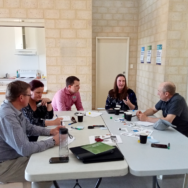How To Stay Ahead Of The Competition
Let’s see how agility & resilience are two sides of one coin...
Being agile and resilient during change are two sides of the same coin called adaptive capacity.
Adaptive capacity refers to an organisation’s ability to quickly adapt to changes in its environment. It includes both the ability to react quickly to changes and the ability to anticipate and plan for changes. Organisations with high adaptive capacity are more likely to be successful in today’s rapidly changing world.
Whilst agility is your ability to move quickly and decisively and to do so with ease and comfort, resilience is your ability to quickly and effectively recover from challenging situations.
Change agility & resilience
To outrun your competition, you need to have both agility and resilience.
Agility allows you to take advantage of opportunities as they arise and to quickly adapt your strategy and plans in response to changes in the marketplace. Resilience ensures that you can rapidly recover from setbacks and continue moving forward toward your goals.
Together, these two qualities give you the ability to thrive in an ever-changing world and to continually stay one step ahead of your competition.
Change-agility embraces the values and principles of the original Agile Manifesto:
Benefits of Change Agility
Forty-two per cent of Fortune 1000 senior leaders who responded to the Protiviti Inc. survey of risk profiles named competition as their most daunting external threat. And 71% of multinational companies surveyed by PWC said that market competition was a leading driver of change in their organisations.
Organisations that build the right kinds of change leaders and improve their change management and change leadership skills and capabilities will be best able to operate in a fast-paced and even turbulent business setting. They will, therefore, outperform other organisations in terms of competitiveness, market share, and profitability.
Agile Change Leaders have learned to optimise their social capital.
Social capital is the relationships and trust that exist within an organisation. It includes the ability to collaborate easily with others, share information freely, and work together to achieve success.

Do you want your next project to succeed?
Don't miss out on this opportunity! The Agile Change Leader course helps you strengthen your social capital and circle of influence to be successful in your next transformation project.
A successful change leader:
The benefits are clearly speed and information. Agile leaders can multiply their impact through the sponsorship network they’ve weaved. Every connection gives them access to information and feedback.
Once an organisation embraces investing time and efforts into practices that build change agility (e.g., effective change management), we observe a virtuous cycle of positive experience of change, assertive trials, innovation and evolutions, more growth and investment in adaptive capacity. (Source)
In the long run, Agile change leaders can observe that there is an increase in information flow and change advocacy across the organisation.
EXCELerate through social capital
Change agility is not a new concept, but it has become increasingly important in recent years as the pace of change has accelerated, and organisations have become more complex.
Successful change leaders stay abreast of the competition by learning and accelerating through social capital. They have earned the trust of their followers and have access to timely information that allows them to make better decisions.
Staying one step ahead is among the primary drivers of change. You must be aware of your competitors’ actions and strategies.
Do you want your next project to succeed?
Don't miss out on this opportunity! The Agile Change Leader course helps you strengthen your social capital and circle of influence to be successful in your next transformation project.

As globalisation, a new generation and accelerated technologies keep challenging businesses to innovate, we observe interesting trends to increase design-thinking and co-creation. These techniques link into establishing practices that create social capital.
Social capital is closely linked to innovation and the speed-to-market. By inviting your employees and customers to the table, you establish relationships and trust early whilst gaining valuable insights into how to design superior solutions fast.
Dr Carol Kinsey Goman, author of the book This Isn’t the Company I Joined: How to Lead in a Business Turned Upside Down, notes two other successful strategies companies use to encourage change agility:

Eva is one of the masterminds behind Approach Services' blog and The 6 Cents of Change. She is an innovator, trainer and change manager. Her work has been published in the Schmalenbach Journal of Business Research. In her spare time, she enjoys camping with her two little boys and permaculture gardening.
Subscribe to our monthly newsletter The 6 Cents of Change and follow us on LinkedIn to learn more!









